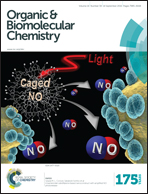Synthesis of novel 5-arylidenethiazolidinones with apoptotic properties via a three component reaction using piperidine as a bifunctional reagent†
Abstract
The synthesis of a new library of 5-arylidenethiazolidinone compounds using an efficient three component reaction with thiazolidine-2,4-dione, piperidine and appropriate aldehydes is reported. This reaction is excellently high yielding, tolerant towards a variety of aldehydes and provides access to these compounds in a single step (in comparison to low yielding multistep syntheses reported in the literature). Once the reaction is complete, the desired product precipitates out of the reaction mixture and is isolated by filtration and purified by washing and recrystallization. These compounds revealed anti-proliferative activities against human breast cancer cells (MCF7 and MDA). Phenotypic profiling established the most active compound 17i (EC50 = 4.52 μM) as an apoptotic agent. A novel chemical proteomics approach identified β-actin-like protein 2, γ-enolase and macrophage migration inhibitory factor (MMIF) as putative cellular binding partners of 17i.


 Please wait while we load your content...
Please wait while we load your content...